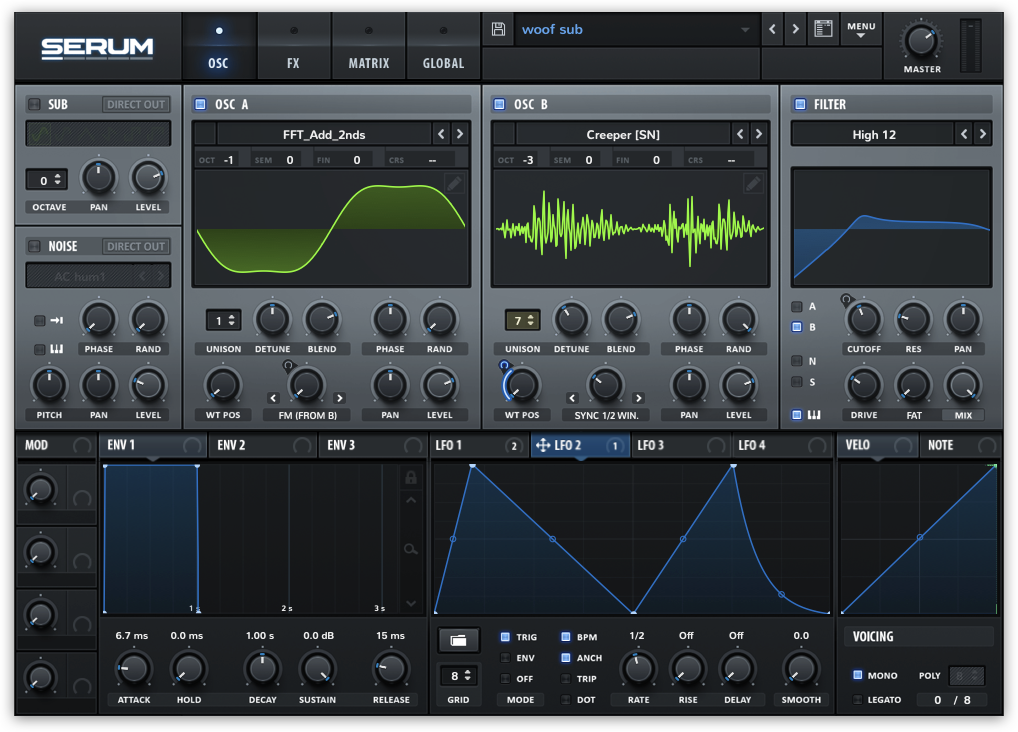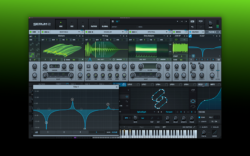I believe the world of synthesizers is truly the key to a large piece of the magic surrounding music production.
In this article, I’ll be focusing specifically on Xfer Records’ Serum to talk about five intuitive techniques I use when designing various sounds. You can hear some of these concepts in action in the tutorial video above, where I share how I made one of the sounds in my new Presets Girlfriend preset pack using Serum 2. That said, these tips can also be applied to a wealth of other synthesizers, whether it be a digital VST or an old-school analog hardware synth.
Explore Serum 2 presets crafted by leading sound designers and producers on Splice.
1. Get to know your synth
The first and most broad of these concepts is the importance of becoming familiar with the unique sound and workflow of your synthesizer. To me, this means on top of just creating and designing your more stock-standard sounds, figuring out the features that are unique to your synth and learning how to apply them.
For instance, one of the oldest tricks I discovered in Serum was the ability to turn off the movement of the flanger, phaser, and chorus effects to create extra flavor. I’ve found most use for this when creating percussive sounds. Turning up the Resonance knobs on any of these parameters creates a feedback layer, much like how a Karplus-Strong synthesizer would work, while having timbres unique to these effects.
An example of this can be heard in this snare sample from my Princess Girlfriend 2 pack, though it definitely shows up in a slew of others:

2. Maximize your wavetables and oscillators
What would usually be used to create your basic tonal timbres can be used to great effect to create interesting textures. I have a lot of fun pitching down complex waveforms to the point where their pitch is indecipherable and their cycles can be heard clearly and distinctly.
From there, I get more interesting movement out of the sound by repeating the process with a second oscillator and using it as an FM source for the first one. Then, it’s just a matter of applying various effects and cleaning up the signal in any way I see fit. This is also a good method to use to get more accustomed to your wavetable library and the specific use cases for each wavetable.
An interesting use case of this technique can be heard in this bass loop, where I used Oscillator B to create a crunchy layer on top of the sub layer:

This alone has the potential to generate a very wide variety of sounds. That said, I feel that it’s important to note that it’s worth playing around with every parameter you can to find new possibilities. I’ve been using Serum since 2016, and I still constantly find new combinations of parameters that lead to interesting sounds. Exploring and maximizing the use of every oscillator has led me to a lot of my most useful and powerful techniques.
3. Use noise and randomization to create variation
A powerful toolset lies within Serum’s Modulation Source bank. Right-clicking a knob or going into the Matrix tab and opening the Modulation Source menu presents you with many more options than the ones that are most apparent (LFOs, envelopes, etc.).
The ones that I find the most useful are the Chaos1, Chaos2, Noise OSC, NoteOn Rand1, and NoteOn Rand2 functions. These functions all have the potential to generate perceived randomness and add variety to your sound, each in slightly different ways.
Chaos1 and Chaos2 both create sporadic LFO curves, not unlike how Perlin noise works, but with added benefits: their rates can be changed, their BPM can be synced, and they even have sample and hold functions to create a constant stream of steady random value outputs. All of these functions can be found in the Global tab.
Meanwhile, the noise oscillator can be used to similar effect by using the loaded sample to create a unique value output that can be used as a modulator. This signal is dependent on whatever noise source has been selected, and the rate can be changed by adjusting the pitch of the noise.
I probably get the most use out of the NoteOn Rand function. It works just like it says on the tin—on MIDI note trigger, these functions will output a random value. I most frequently apply this function to the pan knobs of oscillators or the cutoff of a low-pass filter on a synth pluck to add some life to what’s otherwise a static sound.

4. Find a synth that complements your workflow (and then relentlessly experiment with it)
This one’s a little more abstract. For a lot of reasons, Serum has been my go-to synthesizer for many years; I’d say that the biggest thing that keeps me coming back to it (besides my familiarity with it) is probably its quality-of-life features. From its streamlined and very visual-friendly UI to the ability to save what feels like everything including presets, wavetables, and even FX rack settings—maybe it’s just my own bias speaking, but it just feels like it says yes to everything I want to do with it. When there’s so much synergy between tool and tinkerer, I feel like there’s no fear behind intentionally trying to break it just to see what else it can do.
All of the processes I use to go about designing patches can be boiled down to two concepts. The first is simply hearing a cool sound and trying to recreate it or get something similar. If you do ultimately get there, great—you know how to make a sound you like. If you don’t, that’s also great, because maybe you’ll uncover an even more interesting sound or method.
I think of the second concept as a brain-soupy flow state. Turn off your brain and just throw everything you can think of at a wall and see what sticks. This works especially well if you have a vague concept for a sound but no idea how to get there—you might as well try some things you think will get you there, and try an equal amount of things where you have no clue what the result will be. The only way forward is always going to be forward.
5. Think outside the box
In general, the key to broadening your horizons with synthesis and developing your chops is just playing around. Exploring unfamiliar functions and features and figuring out what they do and how they behave is the most surefire way to not only understand your synth, but to also understand how synthesizers work on a much broader scale. Princess Girlfriend would not exist had I not listened to different drum sounds and just tried to recreate them myself.
As someone who sort of grew up from the outside looking in to the bass music scene, I always felt turned off by the “impress everyone, tell no one” mindset that many producers fell into. I feel it contributes to a lot of the hang-ups that newcomers have coming into this world, which is ripe for exploration and a celebration of individual artistic expression in a way that can be so intimate and so personal.
So, the next time you open a synth to grab a preset, or go looking for one of the many chop snares you have in your samples folder, try pulling up Serum or another synth you like and messing around with it for a little bit—see if you can create something you like more than what you were looking for.
And if you don’t, by all means feel no pressure. Go ahead and load up a preset (that’s what they’re here for)—maybe you’ll start tweaking it and end up creating a sound you really like, and then maybe another, and another…
Find more sources for inspiration with Tracey Brakes’ Serum 2 preset pack:
May 19, 2025

.svg)
.svg)



